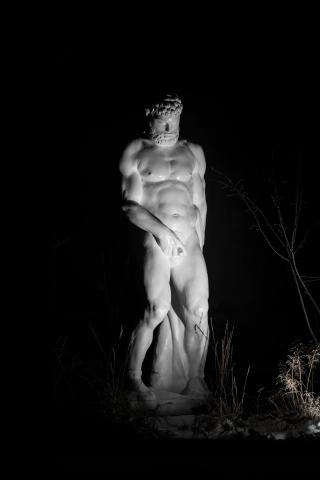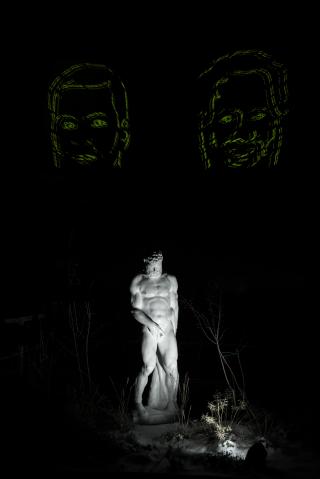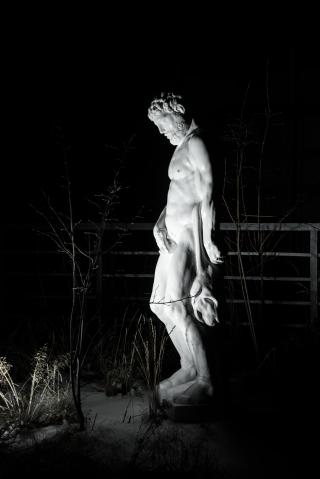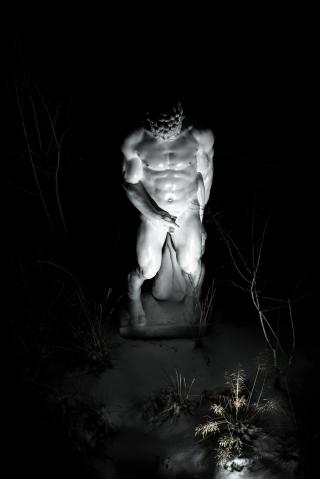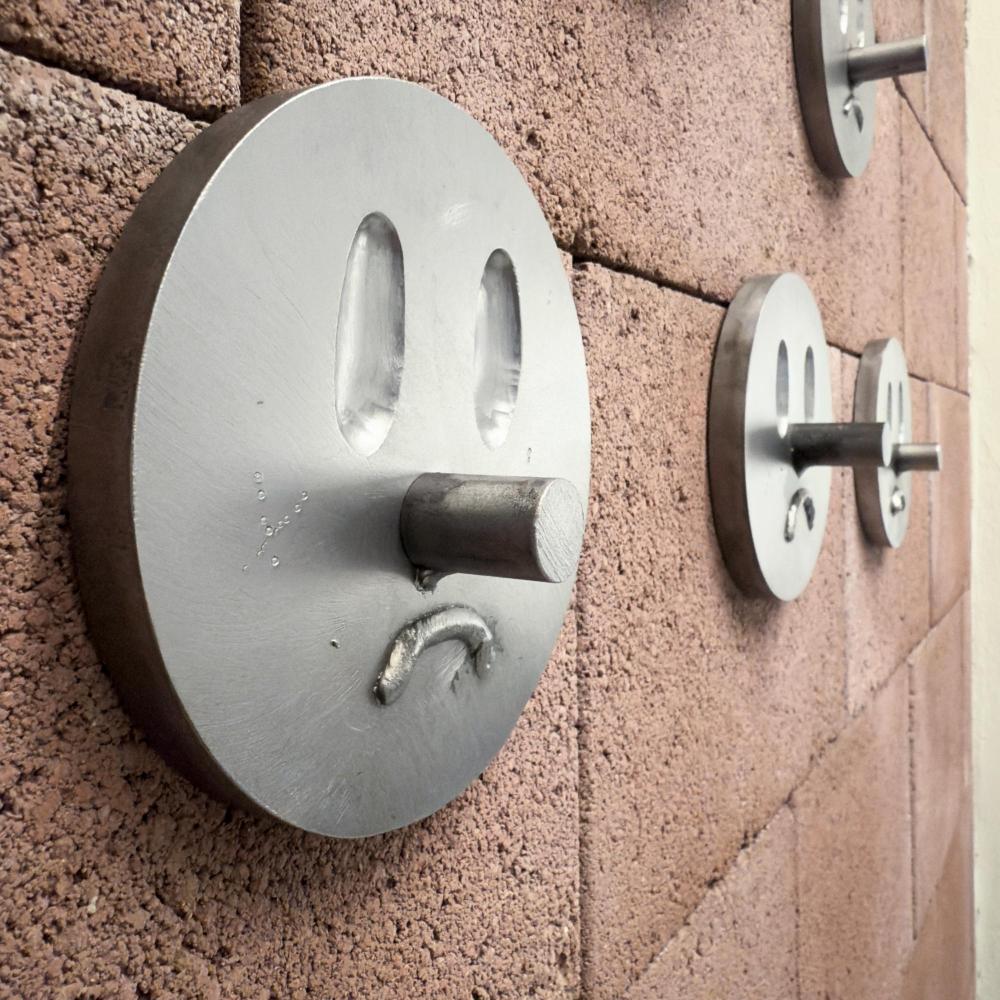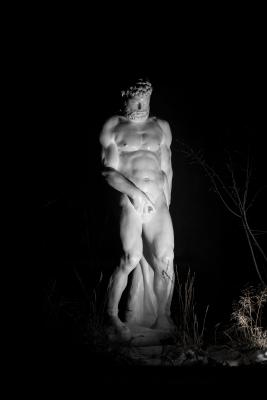
In March and April 2021, we had sculptor in residence Telegraph Gallery sculptor Matouš Háša and that's when the idea of him creating a sculpture for the Telegraph, which is now on the terrace of the loft, was conceived. You can read what he worked on during the residency, how he thinks about his work and what the process of creating the sculpture was like in the following interview.
Would you describe how you spent your time in Olomouc and how it influenced the theme you were working on?
I came to the residency with a few ideas ready to go, which I left after two weeks of work. The restrictions caused by the lockdown did not allow me to visit galleries and museums. So I concentrated on visiting Olomouc's architecture, churches, fountains, statues and other historical monuments. This influenced my choice of topic. I started working with motifs of Christian iconography, which I return to again and again in my work. I try to modify Christian iconography into a contemporary civil position, and the related themes are still applicable and strong for me.
What material did you use in working on this theme and what specifically did you create during the residency?
The baroque decoration of the churches in Olomouc made me want to return to working with wood after many years. Especially the decoration of the Basilica on St. Hill and the Church of St. Moritz. Under this influence, I carved a larger-than-life male figure from pine wood, inspired by the crucifix motif. I had originally planned to model in clay at the residence, but ended up going to the sawmill to collect pine and to find carving chisels. The environment of the residency influenced my work both thematically and craft-wise.
Is working with wood specific in any way?
Yes, it's a specific material that is processed by removing the mass and asking for the final shape itself. Like stone carving, wood carving is a separate discipline in the register of sculptural practices. I think that the motifs chosen to be carved in wood should also somehow create a symbiosis with the material. Not every subject is appropriate for wood. The sculptural approach to working with the material is very close to my heart, and I also use it when finishing sculptures, when I finish them after casting them in artificial stone and then polish them using the same technique as the stone sculptures. For me, wood and stone are a synthesis of intention and working with the material.
What does the process of creating a piece look like for you?
Sketching and finding the right idea almost takes most of my time. I try to be clear about the content and form when I'm conceiving the sculpture, but it happens that I make a big change in the final stage. I try to leave myself room for changes as I work through the process of the material. So I usually make sketches and then sculpt the clay bozzetto, which I use to work on the main sculpture.
How important is the representation of the figure to you?
I'm dedicated to figure work only. The figure, together with antiquity, has been with me from the very beginning. All along I have been studying a particular lineage of figurative sculpture, which in my eyes connects several big names across art history. It starts with Praxiteles, continues with Hellenism, and is then followed by Michelangelo, Rodin. Today I see it in sculptures by Charles Ray, Marc Quinn, Urs Fischer, and others. Basically, I'm inspired by antiquity, even if I'm just inspired by, say, a contemporary artist. So far I don't tend to be concerned with anything other than the figure. Mainly because it is the most natural form of artistic expression for me.
There is a statue of you urinating Hercules on the terrace of the Telegraph. What do you want to convey with this piece?
The concept itself has had a specific evolution. In a way, Hercules was created in a content duet with another sculpture I was preparing for the Central Bohemian Region Gallery in Kutná Hora for the exhibition Solitude in the Midst of a Crowd: Charles Baudelaire and Czech Art. The creation of the sculptures was influenced by the immediate feeling of the figure and their message towards the viewer. Both figures aim to dominate their surroundings with gesture, position, tectonics and energy. While contemplating the subject matter, I became fascinated with the Greek statue of a drunken Hercules and later could not imagine anything else on the roof. Personally, I see the statue as such a symbol of free expression. When I searched for other Greek depictions and other motifs, I came across more sort of controversial depictions of mythological themes. The freedom with which such classical statues are depicted fascinates me.
Is it true that the statue was supposed to have the inscription Cancel on it?
Yes. Both statues, in the germ of my reasoning, should have had a shirt. Both with writing on them. Hercules was supposed to have the Cancel inscription on his shirt, as a reference with multiple meanings, also related to the Cancel Culture theme. In the end, neither of them has a shirt. And even though the Cancel inscription was in the plan at the very beginning, it pretty soon just disappeared for me. Suddenly I didn't want a sculpture that had so much signifying in it, both the urination and the inscription. When I was in residence and in retrospect remembered the Telegraph, it wasn't a place for me that needed multiple gestures and multiplication. As the statue of Hercules was born in front of me, it became a strong man giving a clear and legible signal. However, this explicit gesture, combined with the classical treatment and the chosen material, began to feel a little humble despite its importance. I would have gone over the edge with the gimmick and the lettering. Instead, I gave him a hint of the stylized club and lion skin that are classic attributes of Hercules. At the same time, they act as a support for the standing figure. All that remains of the originally intended civilian clothing are the socks.
What interests you about Cancel Culture?
It's a phenomenon that's hard to ignore. Sometimes I have full sympathy for particular cases and causes, especially when they involve any kind of discrimination or violence. At other times, I am again appalled at the speed with which someone's career can be erased on the basis of, say, a single tweet. Freedom of expression is important to me, and Cancel Culture sometimes goes against that. What I appreciate about art is the freedom and I would hate to see it lost. Everyone has the right to their own opinion and everyone has the right to make fun of something sometimes, even if it goes against hyper-correctness.
It's one of the first sculptures where you don't use an artifact from the present. How did you arrive at this step?
I have never based the meaning of my sculptures on these artifacts. They are more of an accessory for me to enhance their content. Much more has always depended on the context and meaning of the chosen attributes. Recently, I have begun to eliminate artifacts such as the sweatshirt, mask, t-shirt, etc. in favor of the overall expression of the work, which is the primary concern. The absence of the t-shirt is an effort to wrap the present in gesture and context, not accessories. Still, I have not forgiven myself for leaving Hercules' socks on.
The final form of the sculpture is its placement in the architecture. How would you assess the placement of the statue in the Telegraph's space?
I think the placement was successful. On the terrace, the sculpture is a landmark because of its larger-than-life size and the location chosen. The architectural design of the terrace creates a piece of the Greek landscape along with the statue. In addition, Hercules is placed among the greenery where he urinates on the trees. There are several interesting views of the statue, both from the roof of the Telegraph and from the terrace of the café.
Matouš Háša (1992) is a sculptor and a graduate of the Academy of Fine Arts in Prague. In addition, he went through schools in Florence (Libera Accademia di Belle Arti Firenze) and London (Middlesex University London). In response to contemporary cultural and social events, he uses the medium of figurative sculpture, which he places in iconographic contexts as a reminiscence of symbolic or archetypal representations. Stripped of context and interpretation, his work is a formal continuation of the tradition of Western sculpture through a combination of inspiration from classical sculpture (e.g. Michelangelo, Rodin) and contemporary figurative artists (e.g. Marc Quinn, Banksy). Using the content, context of the sculptures' creation and placement, he seeks to apply this tradition without stripping it of its authenticity and spiritual content. In his work, he consciously draws on the "roots" of Western culture, which he translates into the form of a psychoanalytic portrait of postmodern man. He addresses the question of identity, which has been deprived of its mystery and privacy by the contemporary era.
By Mira Macík / Telegraph Gallery
